Hybrid Approach for Detecting Propagandistic Community and Core Node on Social Networks
Abstract
1. Introduction
- An AI-based framework is proposed for detecting propagandistic communities and propagandists.
- Leader Ranker Algorithm is used for mining the candidate nodes within the interior of a community.
- Constraint Coefficient is used for mining candidate nodes within the boundary of a community.
- The Boundary-based Community Detection Approach (BCDA) has been proposed to identify the core nodes in a propagandistic community based on the interior and boundary nodes, which over-performed the existing approaches such as Degree Discount, Greedy, etc., in terms of running time.
- A novel dataset collected from the Twitter blogging site was generated out of this study. This dataset consists of 16 attributes considered favorable for propagandistic community detection research. The dataset will be available for the researcher of this domain.
2. Related Work
- The work on finding propagandistic communities is in its infancy. To our knowledge, very less literature has been found regarding the same.
- Traditional algorithms are used for detecting community structure.
- Less work has been conducted on Social Media data.
- The core members responsible for sharing the propaganda among communities need to be identified to help law enforcement agencies break the chain.
3. Background Knowledge
3.1. Newman and Girvan Algorithm
- Compute edge betweenness for every edge in the graph.
- Take away the edge with the greatest edge betweenness.
- Compute edge betweenness for remaining edges.
- Repeat steps 2–4 until all edges are removed.
3.2. Random Walk
- If two nodes i and j belong to the same community, the likelihood of accessing node j from i is greater than visiting a node outside the community. Even though the likelihood is high, this does not imply that they are members of the same community.
- Because the walker tends to visit vertices with high degrees, the probability is dependent on the degree of j.
- Two vertices in the same community have a tendency to see all other vertices in the same way, and ≈, ∀∈ same community and .
4. Materials and Methods
- Propaganda Detection;
- Community Detection;
- Influence Maximization (IM) of community structure.
- k clustering centers are chosen at random.
- Calculate how similar each point is to the center.
- Organize the points into clusters if their similarity is below the threshold.
- Repeat steps 2 and 3 until the center is unmodified, then update the cluster centers.
4.1. Finding Candidate Nodes within the Community
4.2. Finding Candidate Nodes from the Boundary
4.3. Core Nodes Selection
| Algorithm 1 Boundary-based Community Detection Approach (BCDA) |
|
5. Results and Discussion
Comparative Study
- Greedy: Greedy algorithm is used to solve the problem of influence maximization. The greedy algorithm iteratively selects the nodes with the greatest marginal influence, due to which it has a very high-performance [49].
- ICRIM:To reduce the temporal complexity of Greedy, Improved Community-based Robust Influence Maximization (ICRIM) separates the network into multiple independent communities and then searches for core nodes within each community [50].
- CBIMA: Community-Based Influence Maximization Approach (CBIMA) identifies the influential nodes using community structure and influence distribution difference [51].
- Degree Discount: It is a heuristic algorithm based on the network structure [52].
6. Conclusions
Author Contributions
Funding
Institutional Review Board Statement
Informed Consent Statement
Data Availability Statement
Acknowledgments
Conflicts of Interest
References
- Raj, E.D.; Manogaran, G.; Srivastava, G.; Wu, Y. Information granulation-based community detection for social networks. IEEE Trans. Comput. Soc. Syst. 2020, 8, 122–133. [Google Scholar] [CrossRef]
- Fani, H.; Bagheri, E. Community detection in social networks. Encycl. Semant. Comput. Robot. Intell. 2017, 1, 1630001. [Google Scholar] [CrossRef]
- Liu, Z.; Ma, Y. A divide and agglomerate algorithm for community detection in social networks. Inf. Sci. 2019, 482, 321–333. [Google Scholar] [CrossRef]
- Wu, Z.H.; Lin, Y.F.; Gregory, S.; Wan, H.Y.; Tian, S.F. Balanced multi-label propagation for overlapping community detection in social networks. J. Comput. Sci. Technol. 2012, 27, 468–479. [Google Scholar] [CrossRef]
- Pattanayak, H.S.; Sangal, A.L.; Verma, H.K. Community detection in social networks based on fire propagation. Swarm Evol. Comput. 2019, 44, 31–48. [Google Scholar] [CrossRef]
- Bedi, P.; Sharma, C. Community detection in social networks. Wiley Interdiscip. Rev. Data Min. Knowl. Discov. 2016, 6, 115–135. [Google Scholar] [CrossRef]
- Khanday, A.M.U.D.; Rabani, S.T.; Khan, Q.R.; Malik, S.H. Detecting twitter hate speech in COVID-19 era using machine learning and ensemble learning techniques. Int. J. Inf. Manag. Data Insights 2022, 2, 100120. [Google Scholar] [CrossRef]
- Wani, M.A.; Sofi, M.A.; Wani, S.Y. Why Fake Profiles: A study of Anomalous users in different categories of Online Social Networks. Int. J. Eng. Technol. Sci. Res. 2017, 4, 320–329. [Google Scholar]
- Wani, M.A.; Agarwal, N.; Bours, P. Sexual-predator detection system based on social behavior biometric (SSB) features. Procedia Comput. Sci. 2021, 189, 116–127. [Google Scholar] [CrossRef]
- He, K.; Li, Y.; Soundarajan, S.; Hopcroft, J.E. Hidden community detection in social networks. Inf. Sci. 2018, 425, 92–106. [Google Scholar] [CrossRef]
- Wu, L.; Zhang, Q.; Chen, C.H.; Guo, K.; Wang, D. Deep learning techniques for community detection in social networks. IEEE Access 2020, 8, 96016–96026. [Google Scholar] [CrossRef]
- Zhao, Z.; Feng, S.; Wang, Q.; Huang, J.Z.; Williams, G.J.; Fan, J. Topic oriented community detection through social objects and link analysis in social networks. Knowl.-Based Syst. 2012, 26, 164–173. [Google Scholar] [CrossRef]
- Golbeck, J. Network structure and measures. Anal. Soc. Web 2013, 25–44. [Google Scholar] [CrossRef]
- Newman, M.E.; Girvan, M. Finding and evaluating community structure in networks. Phys. Rev. E 2004, 69, 026113. [Google Scholar] [CrossRef] [PubMed]
- Wan, L.; Liao, J.; Zhu, X. Cdpm: Finding and evaluating community structure in social networks. In Proceedings of the International Conference on Advanced Data Mining and Applications; Springer: Berlin/Heidelberg, Germany, 2008; pp. 620–627. [Google Scholar]
- Liu, J.S.; Ning, K.C.; Chuang, W.C. Discovering and characterizing political elite cliques with evolutionary community detection. Soc. Netw. Anal. Min. 2013, 3, 761–783. [Google Scholar] [CrossRef]
- Bhat, S.Y.; Abulaish, M. Using communities against deception in online social networks. Comput. Fraud Secur. 2014, 2014, 8–16. [Google Scholar] [CrossRef]
- Sutaria, K.; Joshi, D.; Bhensdadia, C.; Khalpada, K. An adaptive approximation algorithm for community detection in social network. In Proceedings of the 2015 IEEE International Conference on Computational Intelligence & Communication Technology, Ghaziabad, India, 13–14 February 2015; pp. 785–788. [Google Scholar]
- Hasanzadeh, F.; Jalali, M.; Jahan, M.V. Detecting communities in social networks by techniques of clustering and analysis of communications. In Proceedings of the IEEE 2014 Iranian Conference on Intelligent Systems (ICIS), Bam, Iran, 4–6 February 2014; pp. 1–5. [Google Scholar]
- Rao, B.; Mitra, A. A new approach for detection of common communities in a social network using graph mining techniques. In Proceedings of the IEEE 2014 International Conference on High Performance Computing and Applications (ICHPCA), Bhubaneswar, India, 22–24 December 2014; pp. 1–6. [Google Scholar]
- Roy, S.D.; Lotan, G.; Zeng, W. The attention automaton: Sensing collective user interests in social network communities. IEEE Trans. Netw. Sci. Eng. 2015, 2, 40–52. [Google Scholar] [CrossRef]
- Aylani, A.; Goyal, N. Community detection in social network based on useras social activities. In Proceedings of the IEEE 2017 International Conference on I-SMAC (IoT in Social, Mobile, Analytics and Cloud) (I-SMAC), Palladam, India, 10–11 February 2017; pp. 625–628. [Google Scholar]
- Wani, M.A.; Jabin, S. Mutual clustering coefficient-based suspicious-link detection approach for online social networks. J. King Saud Univ.-Comput. Inf. Sci. 2018, 34, 218–231. [Google Scholar] [CrossRef]
- Wani, M.A.; Agarwal, N.; Jabin, S.; Hussain, S.Z. Analyzing Real and Fake users in Facebook Network based on Emotions. In Proceedings of the 2019 11th International Conference on Communication Systems & Networks (COMSNETS), Bangalore, India, 7–11 January 2019; pp. 110–117. [Google Scholar] [CrossRef]
- Wani, M.A.; Agarwal, N.; Jabin, S.; Hussain, S.Z. User emotion analysis in conflicting versus non-conflicting regions using online social networks. Telemat. Inform. 2018, 35, 2326–2336. [Google Scholar] [CrossRef]
- Xie, J.; Szymanski, B.K. Towards linear time overlapping community detection in social networks. In Proceedings of the Pacific-Asia Conference on Knowledge Discovery and Data Mining; Springer: Berlin/Heidelberg, Germany, 2012; pp. 25–36. [Google Scholar]
- Wang, M.; Wang, C.; Yu, J.X.; Zhang, J. Community detection in social networks: An in-depth benchmarking study with a procedure-oriented framework. Proc. VLDB Endow. 2015, 8, 998–1009. [Google Scholar] [CrossRef]
- Kanavos, A.; Perikos, I.; Hatzilygeroudis, I.; Tsakalidis, A. Emotional community detection in social networks. Comput. Electr. Eng. 2018, 65, 449–460. [Google Scholar] [CrossRef]
- Ahajjam, S.; El Haddad, M.; Badir, H. A new scalable leader-community detection approach for community detection in social networks. Soc. Netw. 2018, 54, 41–49. [Google Scholar] [CrossRef]
- Jonnalagadda, A.; Kuppusamy, L. A survey on game theoretic models for community detection in social networks. Soc. Netw. Anal. Min. 2016, 6, 1–24. [Google Scholar] [CrossRef]
- You, X.; Ma, Y.; Liu, Z. A three-stage algorithm on community detection in social networks. Knowl.-Based Syst. 2020, 187, 104822. [Google Scholar] [CrossRef]
- Despalatović, L.; Vojković, T.; Vukicević, D. Community structure in networks: Girvan-Newman algorithm improvement. In Proceedings of the IEEE 2014 37th International Convention on Information and Communication Technology, Electronics and Microelectronics (MIPRO), Opatija, Croatia, 26–30 May 2014; pp. 997–1002. [Google Scholar]
- Bickel, P.J.; Chen, A. A nonparametric view of network models and Newman–Girvan and other modularities. Proc. Natl. Acad. Sci. USA 2009, 106, 21068–21073. [Google Scholar] [CrossRef]
- Hurajová, J.C.; Madaras, T. Revising the Newman-Girvan Algorithm. ITAT 2016, 1649, 200–205. [Google Scholar]
- Fortunato, S. Community detection in graphs. Phys. Rep. 2010, 486, 75–174. [Google Scholar] [CrossRef]
- Lai, D.; Lu, H.; Nardini, C. Enhanced modularity-based community detection by random walk network preprocessing. Phys. Rev. E 2010, 81, 066118. [Google Scholar] [CrossRef]
- Eriksson, A.; Edler, D.; Rojas, A.; de Domenico, M.; Rosvall, M. How choosing random-walk model and network representation matters for flow-based community detection in hypergraphs. Commun. Phys. 2021, 4, 1–12. [Google Scholar]
- Okuda, M.; Satoh, S.; Sato, Y.; Kidawara, Y. Community detection using restrained random-walk similarity. IEEE Trans. Pattern Anal. Mach. Intell. 2019, 43, 89–103. [Google Scholar] [CrossRef]
- Girvan, M.; Newman, M.E. Community structure in social and biological networks. Proc. Natl. Acad. Sci. USA 2002, 99, 7821–7826. [Google Scholar] [CrossRef] [PubMed]
- Li, J.; Yu, Y. Scalable influence maximization in social networks using the community discovery algorithm. In Proceedings of the IEEE 2012 Sixth International Conference on Genetic and Evolutionary Computing, Kitakyushu, Japan, 25–28 August 2012; pp. 284–287. [Google Scholar]
- Li, X.; Cheng, X.; Su, S.; Sun, C. Community-based seeds selection algorithm for location aware influence maximization. Neurocomputing 2018, 275, 1601–1613. [Google Scholar] [CrossRef]
- Khanday, A.M.U.D.; Bhushan, B.; Jhaveri, R.H.; Khan, Q.R.; Raut, R.; Rabani, S.T. NNPCov19: Artificial Neural Network-Based Propaganda Identification on Social Media in COVID-19 Era. Mob. Inf. Syst. 2022, 2022, 3412992. [Google Scholar] [CrossRef]
- Khanday, A.M.U.D.; Khan, Q.R.; Rabani, S.T. Detecting textual propaganda using machine learning techniques. Baghdad Sci. J. 2021, 18, 199–209. [Google Scholar]
- Kempe, D.; Kleinberg, J.; Tardos, É. Maximizing the spread of influence through a social network. In Proceedings of the Ninth ACM SIGKDD International Conference on Knowledge Discovery and Data Mining, Washington, DC, USA, 24–27 August 2003; pp. 137–146. [Google Scholar]
- Wang, Y.; Feng, X. A potential-based node selection strategy for influence maximization in a social network. In Proceedings of the International Conference on Advanced Data Mining and Applications; Springer: Berlin/Heidelberg, Germany, 2009; pp. 350–361. [Google Scholar]
- Song, G.; Li, Y.; Chen, X.; He, X.; Tang, J. Influential node tracking on dynamic social network: An interchange greedy approach. IEEE Trans. Knowl. Data Eng. 2016, 29, 359–372. [Google Scholar] [CrossRef]
- Sun, J.; Tang, J. A survey of models and algorithms for social influence analysis. In Social Network Data Analytics; Springer: New York, NY, USA, 2011; pp. 177–214. [Google Scholar]
- Blondel, V.D.; Guillaume, J.L.; Lambiotte, R.; Lefebvre, E. Fast unfolding of communities in large networks. J. Stat. Mech. Theory Exp. 2008, 2008, P10008. [Google Scholar] [CrossRef]
- Zhang, X.; Zhu, J.; Wang, Q.; Zhao, H. Identifying influential nodes in complex networks with community structure. Knowl.-Based Syst. 2013, 42, 74–84. [Google Scholar] [CrossRef]
- Ye, F.; Liu, J.; Chen, C.; Ling, G.; Zheng, Z.; Zhou, Y. Identifying Influential Individuals on Large-Scale Social Networks: A Community Based Approach. IEEE Access 2018, 6, 47240–47257. [Google Scholar] [CrossRef]
- Zhang, Z.; Li, X.; Gan, C. Identifying influential nodes in social networks via community structure and influence distribution difference. Digit. Commun. Netw. 2021, 7, 131–139. [Google Scholar] [CrossRef]
- Wang, X.; Zhang, X.; Zhao, C.; Yi, D. Maximizing the Spread of Influence via Generalized Degree Discount. PLoS ONE 2016, 11, e0164393. [Google Scholar] [CrossRef]
- Veličković, P.; Cucurull, G.; Casanova, A.; Romero, A.; Lio, P.; Bengio, Y. Graph attention networks. arXiv 2017, arXiv:1710.10903. [Google Scholar]
- Shchur, O.; Mumme, M.; Bojchevski, A.; Günnemann, S. Pitfalls of graph neural network evaluation. arXiv 2018, arXiv:1811.05868. [Google Scholar]
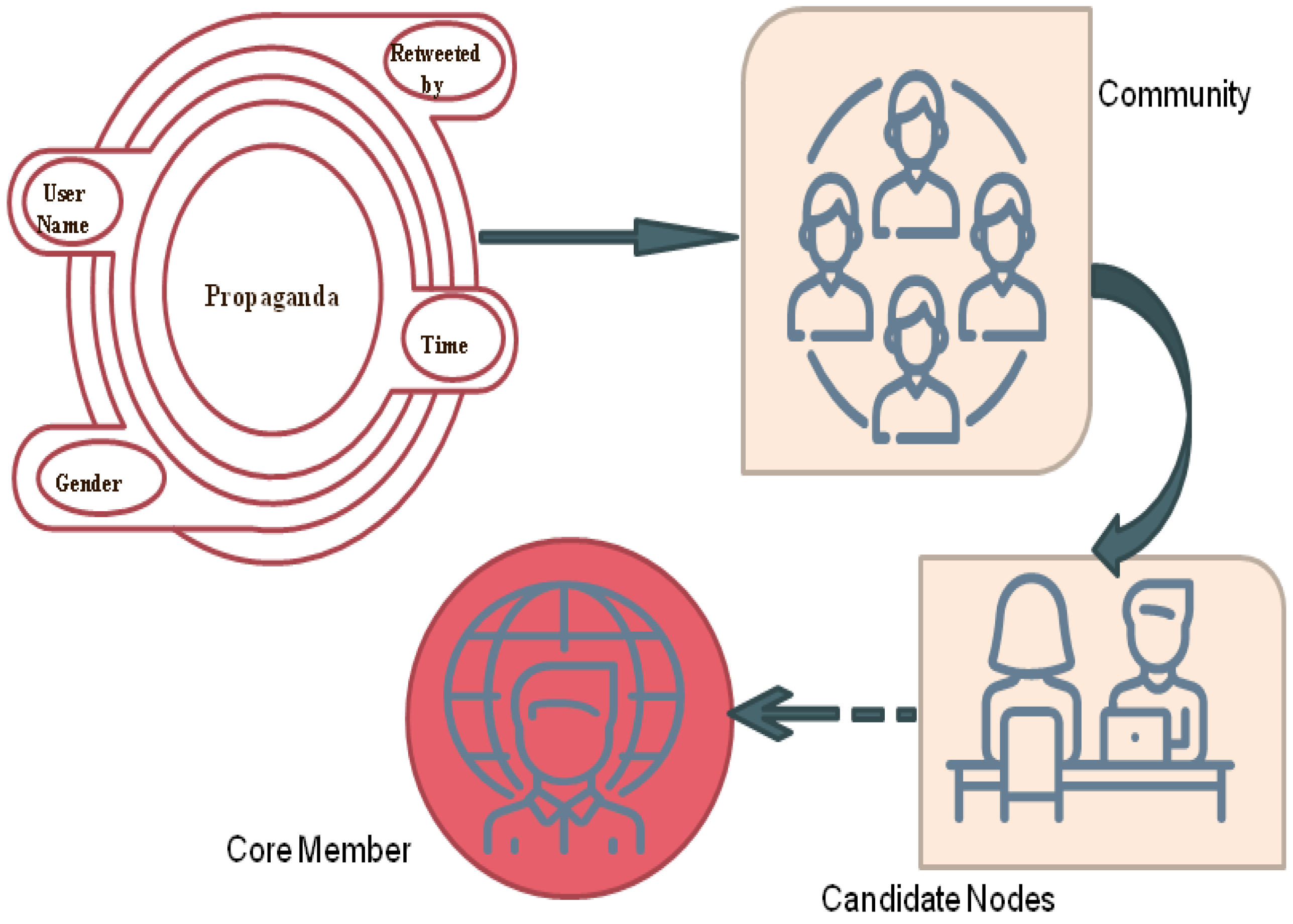


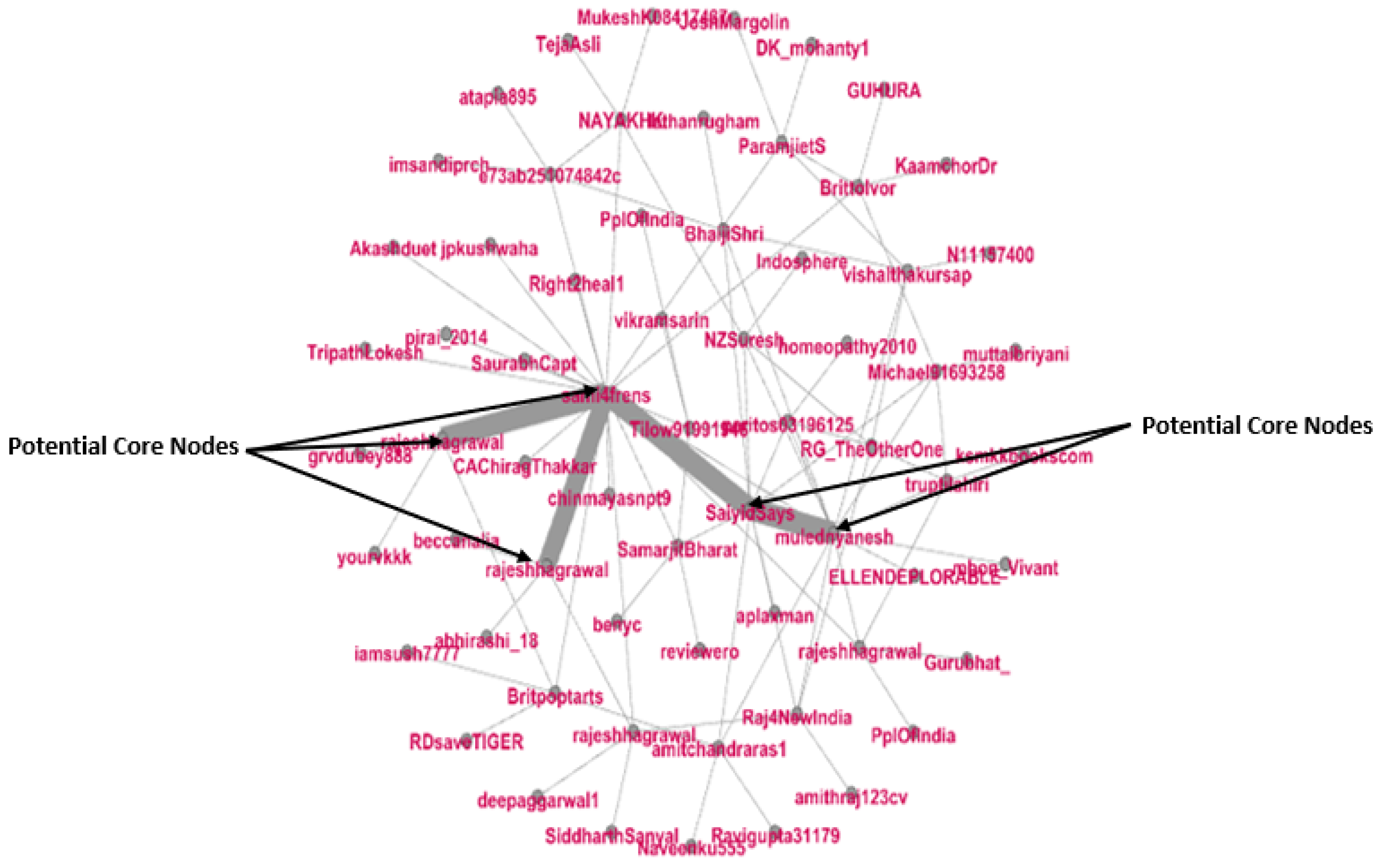
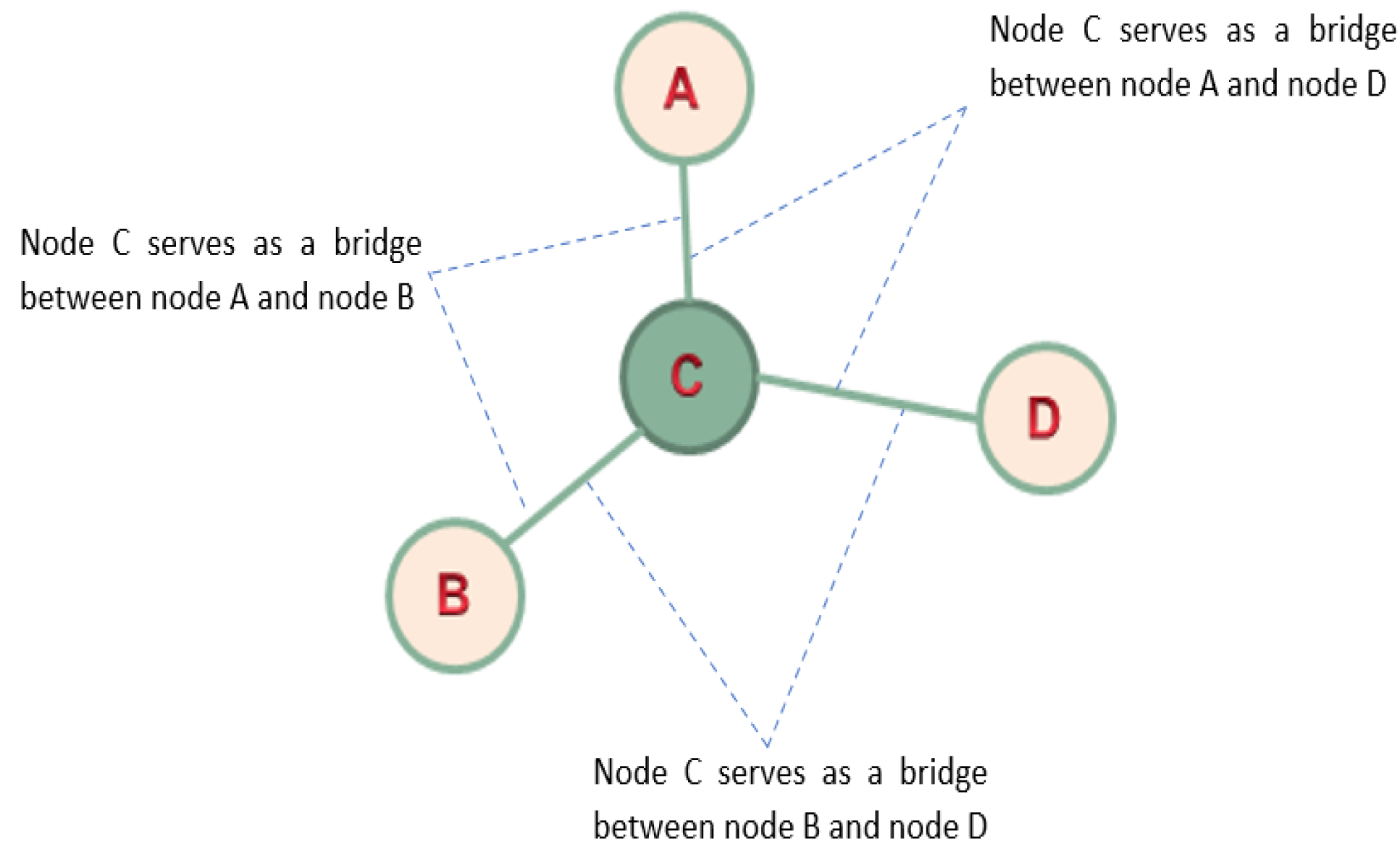
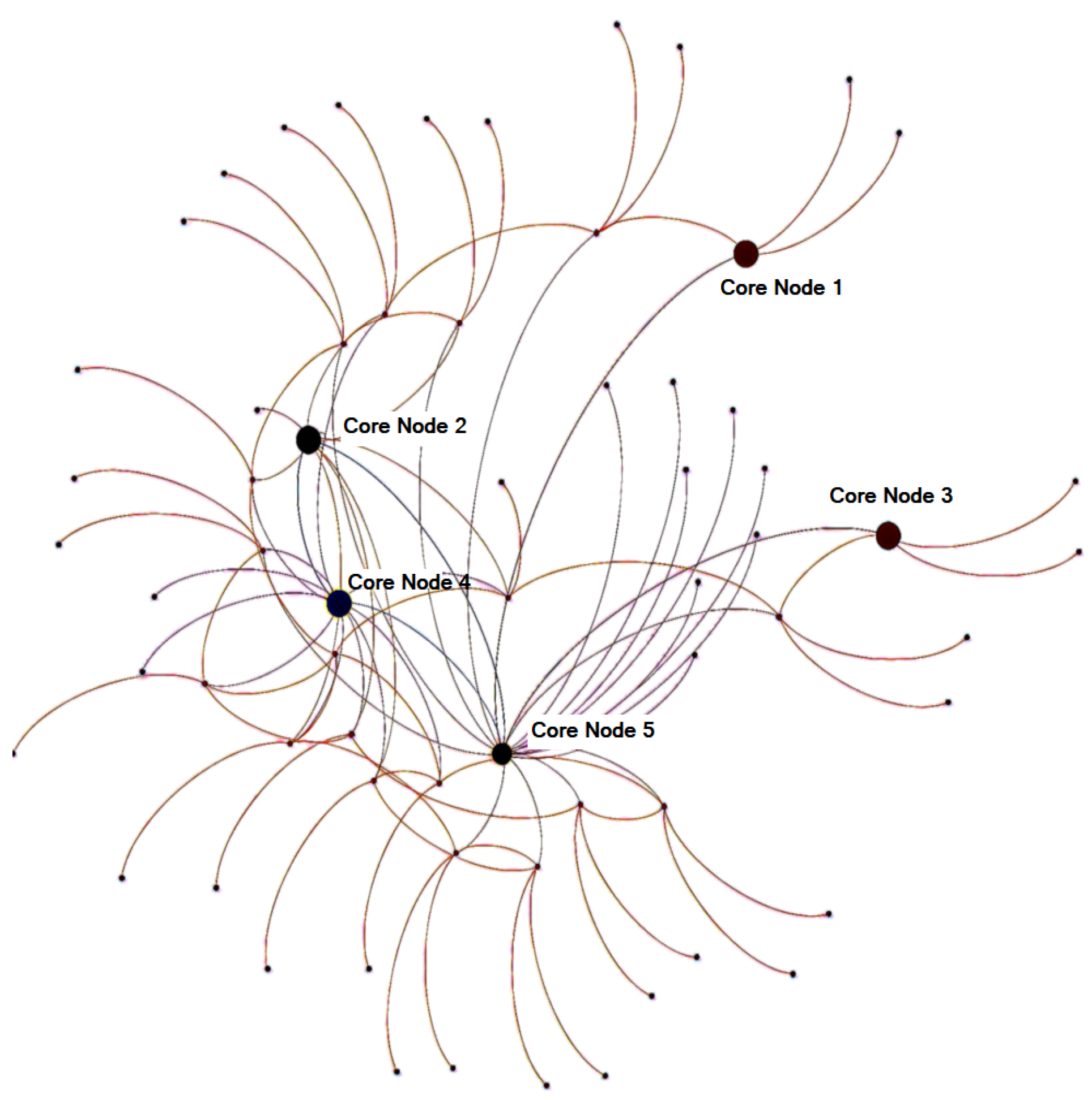
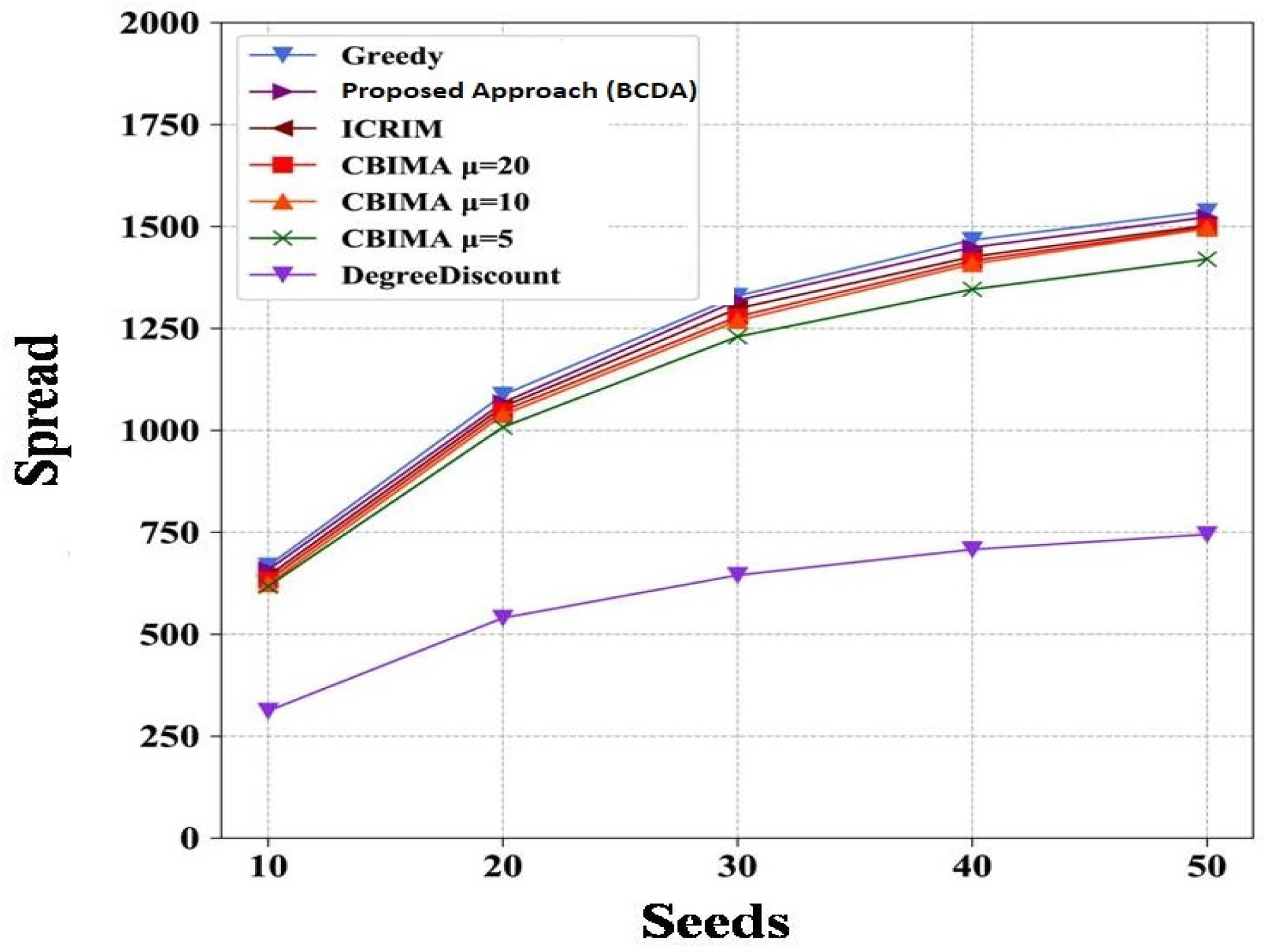
Disclaimer/Publisher’s Note: The statements, opinions and data contained in all publications are solely those of the individual author(s) and contributor(s) and not of MDPI and/or the editor(s). MDPI and/or the editor(s) disclaim responsibility for any injury to people or property resulting from any ideas, methods, instructions or products referred to in the content. |
© 2023 by the authors. Licensee MDPI, Basel, Switzerland. This article is an open access article distributed under the terms and conditions of the Creative Commons Attribution (CC BY) license (https://creativecommons.org/licenses/by/4.0/).
Share and Cite
Khanday, A.M.U.D.; Wani, M.A.; Rabani, S.T.; Khan, Q.R. Hybrid Approach for Detecting Propagandistic Community and Core Node on Social Networks. Sustainability 2023, 15, 1249. https://doi.org/10.3390/su15021249
Khanday AMUD, Wani MA, Rabani ST, Khan QR. Hybrid Approach for Detecting Propagandistic Community and Core Node on Social Networks. Sustainability. 2023; 15(2):1249. https://doi.org/10.3390/su15021249
Chicago/Turabian StyleKhanday, Akib Mohi Ud Din, Mudasir Ahmad Wani, Syed Tanzeel Rabani, and Qamar Rayees Khan. 2023. "Hybrid Approach for Detecting Propagandistic Community and Core Node on Social Networks" Sustainability 15, no. 2: 1249. https://doi.org/10.3390/su15021249
APA StyleKhanday, A. M. U. D., Wani, M. A., Rabani, S. T., & Khan, Q. R. (2023). Hybrid Approach for Detecting Propagandistic Community and Core Node on Social Networks. Sustainability, 15(2), 1249. https://doi.org/10.3390/su15021249








